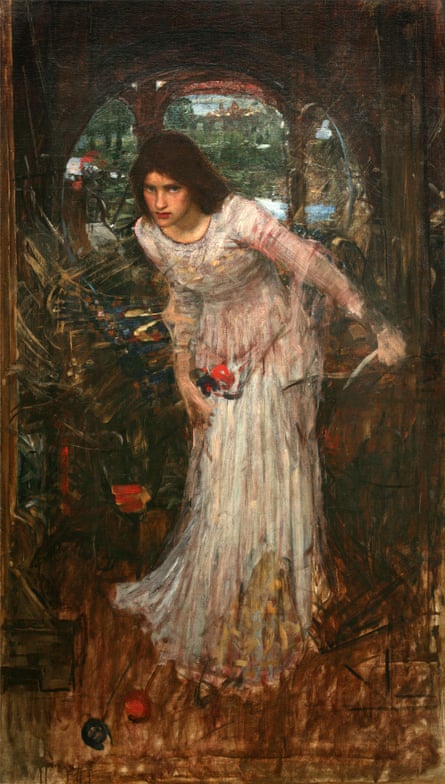This painting was bought from the artist by Alfred A De Pass, a South African businessman and art collector who settled in Falmouth and strongly regarded it as his home; Falmouth Art Gallery Collection was founded largely by the generous gift of his, in 1923. He had three paintings by Waterhouse in his collection; two are in Falmouth.
Waterhouse depicts Tennyson’s famous poem The Lady of Shalott, which tells the story from Arthurian legend of The Lily Maid of Astolat.

Waterhouse catches the fluid moment of Tennyson’s poem when Elaine spins to look out of the window for Lancelot, catching herself in the wool from her tapestry, falling towards the window, clutching her scissors almost like a knight’s sword.
This preparatory oil sketch is the study for the finished painting that is now in Leeds Art Gallery, and shows the artist working through a process of storytelling. In this study Camelot can be seen clearly in the background, behind the river, but it is not so apparent in the final piece. Equally Lancelot’s position is reversed.
The Arthurian legends and their tales of chivalry, courtly love and enchantments held particular fascination for the Victorians. Tennyson himself visited Cornwall in 1860 to retrace King Arthur’s footsteps, shortly after he published Idylls of the King, a collection of 12 narrative poems which retell the legend of King Arthur, his knights, his love for Guinevere and her tragic betrayal of him, and the rise and fall of Arthur’s kingdom.
Waterhouse too returned to the King Arthur legends many times and made two other major paintings depicting scenes from the Tennyson poem. In 1888, he painted the Lady setting out for Camelot in her boat – now part of the Tate Gallery London’s collection, and in 1915, Waterhouse made I Am Half-Sick of Shadows, Said the Lady of Shalott, a work now in Toronto.
This painting is known throughout the world and is our collection’s most famous work. It regularly travels far and wide for touring exhibitions – much to the disappointment of local visitors. Viewers are often delighted to hear how it is connected to Arthurian Legend, and the relevance of the legend to Cornwall, the legendary home of King Arthur and his Round Table.
You can see more art from Falmouth Art Gallery on Art UK here, and find out more on the gallery’s website.
This series is brought to you in collaboration with Art UK, which brings the nation’s art together on one digital platform and tells the stories behind the art. The website shows works by 50,000 artists from more than 3,000 venues including museums, universities and hospitals as well as thousands of public sculptures. Discover the art you own here.

Comments (…)
Sign in or create your Guardian account to join the discussion